Предмет: Английский язык,
автор: sanekrussak1992
2 at these impressive birds of prey. Habitat and distribution Golden eagles are fairly widespread in Kazakhstan, inhabiting open country such as mountains, steppo. and desert. There are four subspecies of golden eagle in the country, and each one generally breeds in a different area. although their territories sometimes overlap. The chrysaetos subspecies most commonly nests in the west, the kamtschatica in the north, the homoyeri in the Kyzylkum Desert and the daphanea in the Tien Shan Mountains. Appearance & Behaviour The name of these beautiful birds might seem misleading at first, because their plumage is mainly dark brown. However, their name comes from the golden feathers on their heads and necks. Like other raptors, they have sharp talons to snatch up their prey and hooked beaks to help them consume it. As one of the largest birds of prey, full-grown adults can weigh between 3 and 6.6 kg, and their wingspan can be over two metres! They soar high on air currents conserving energy by reducing the need to beat their enormous wings. They are still capable of achieving great speeds though they can dive at up to 240 km per hour! Golden eagles often engage in aerial play, dropping a stick mid- air and diving to catch it before it reaches the ground. A Diet Golden eagles are carnivores and prey on rodents, hares, rabbits, and even foxes. They usually capture live prey, but they also feed on carrion. What makes them expert hunters is their amazing eyesight - they can detect small animals at distances of 1.5 km! Their large eyes function far better than human eyes in daylight because, while our retinas contains 200,000 cones-the cells that help us differentiate between colours per square millimetre, golden eagles have about a million! Nesting Golden eagles often mate for life and build their nest together, returning to it for multiple breeding seasons. In some cases, nests have been used continuously for decades. Golden eagles begin reproducing at 4-5 years old and can live for up to 30 years in the wild. An eagle's nest is called an eyrie, and it can be 1.5 metres across, or even larger. The female lays 1-3 eggs in the nest, and the incubation period is about 45 days. It takes another 60-70 days for the chicks to fledge and about 100 days for them to become independent and leave their parents. Conservation Sadly, golden eagles are in danger in Kazakhstan, and have been for the past 30 years, due to the illegal hunting of adult eagles and accidental deaths on electrical power lines. Conservation groups have been working to change the situation, and the Sunkar Reserve is currently breeding golden eagles and releasing them into the wild each year to increase the population. Thanks to this initiative, the future of Kazakhstan's beloved eagle looks bright once again.
помогите пожалуйста перевести ставлю все свои баллы
не занаешь что попало не пеши
Приложения:

Ответы
Автор ответа:
3
можно же в переводчике
Похожие вопросы
Предмет: Другие предметы,
автор: darxanaj
Предмет: Русский язык,
автор: evadavitadze1711
Предмет: Математика,
автор: akira81
Предмет: Математика,
автор: marieatam23
Предмет: Математика,
автор: eliseevataisia